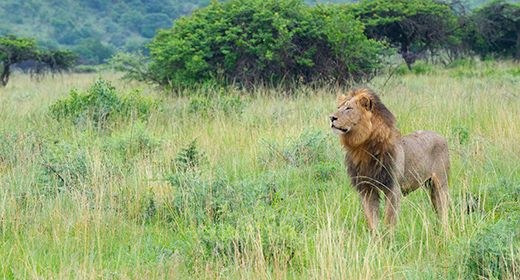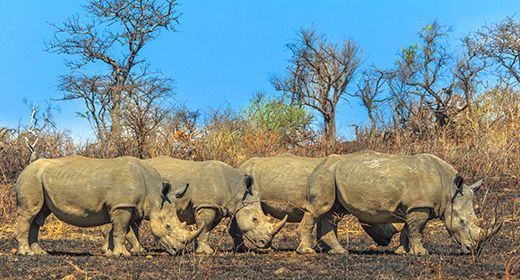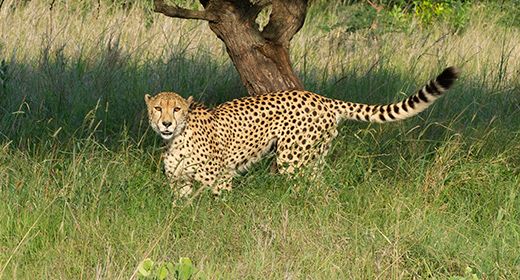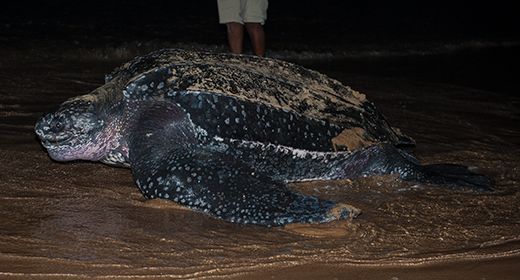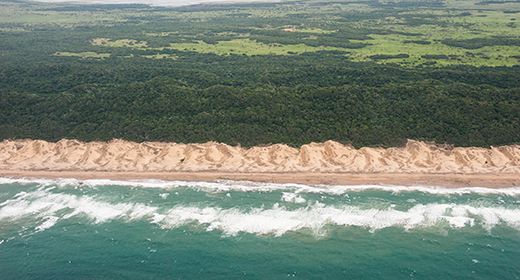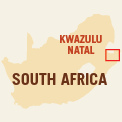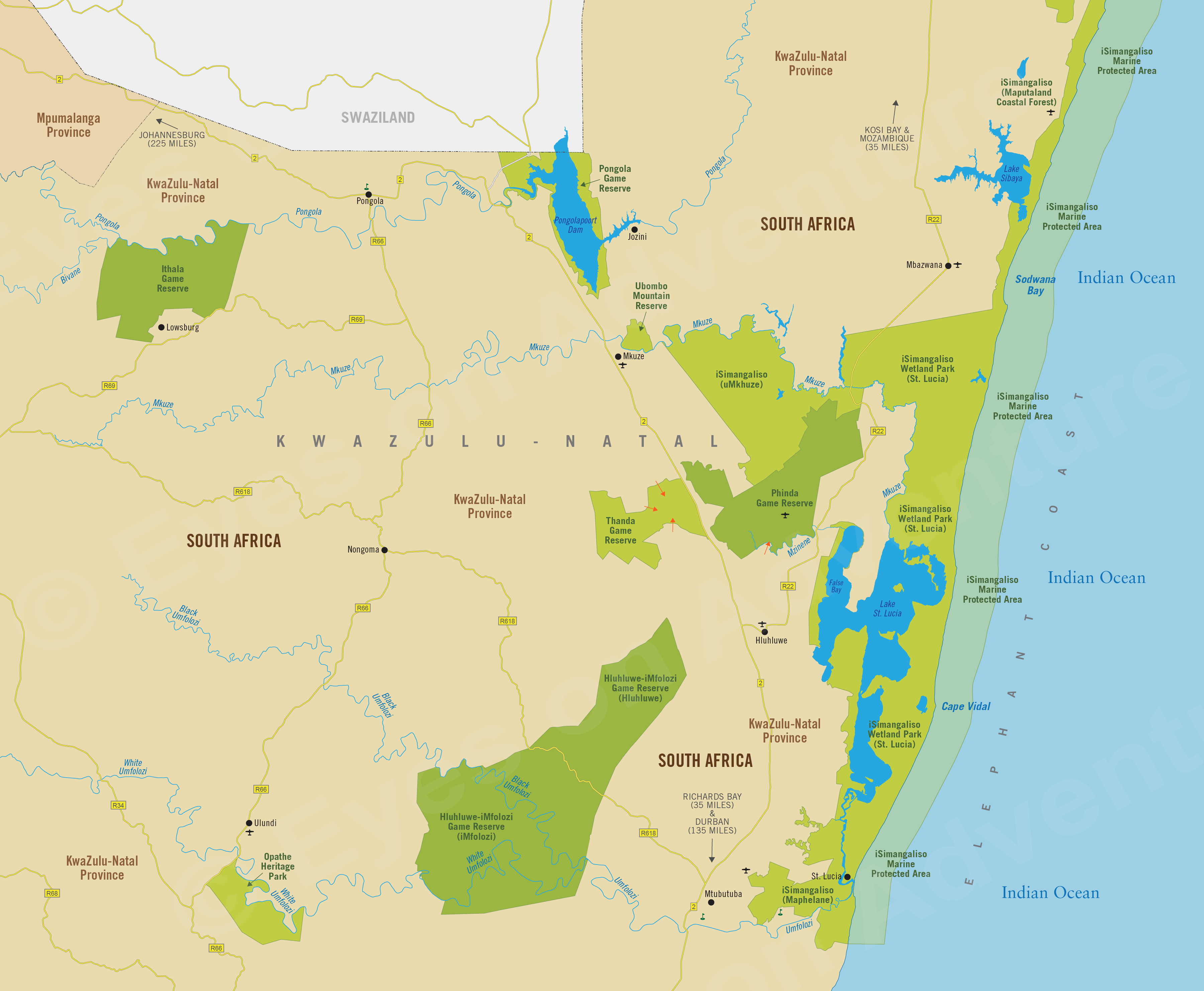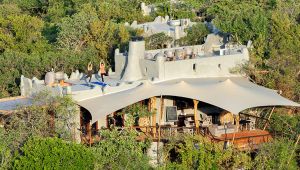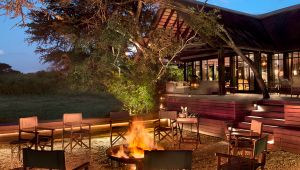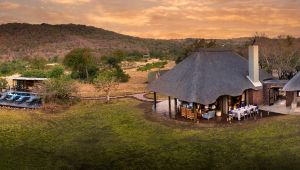KwaZulu-Natal
(incl. Phinda, Thanda, iSimangaliso, Hluhluwe-iMfolozi, Elephant Coast)
Region Links: Cape Peninsula, Cape Town, Cape West Coast, Cape Winelands, Eastern Cape, Garden Route, Gauteng Province, Johannesburg, Kruger Park & Lowveld, Kruger Private Reserves, KwaZulu-Natal, Madikwe, Overberg & Whale Coast, Pilanesberg & Sun City, Sabi Sand Reserve
Highlights
- Visit the game-rich, conservation-focused wildlife reserves
- Explore the protected coastline in Isimangaliso Wetland Park
- Experience the wonder of sea turtles nesting and hatchlings emerging
- Explore the Zulu culture throughout the region
- Enjoy some of Africa's best SCUBA diving on pristine coral reefs
EOA Recommends: Phinda Forest Lodge, Phinda Vlei Lodge, Rocktail Camp, Thanda Safari Lodge
South Africa's KwaZulu-Natal (KZN) Province is known for its beaches, coastal forests, game reserves, mountains and the Zulu culture. The northern section of the province is home to some of the country's best wildlife viewing.
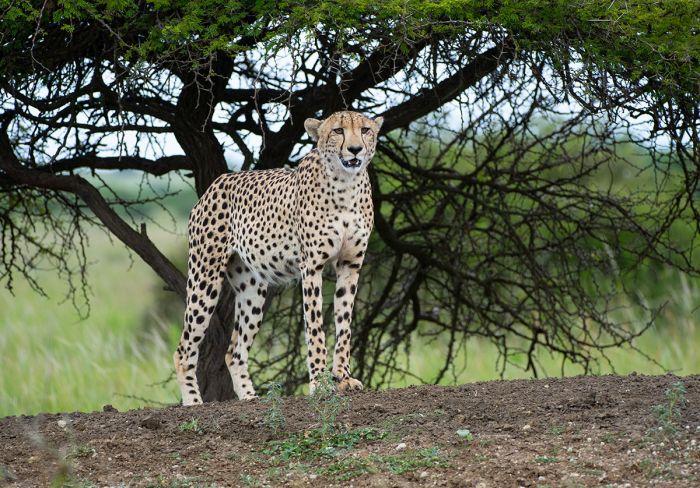
Cheetah in the Phinda Game Reserve (Copyright © James Weis).
The Elephant Coast
The Elephant Coast spans 200 kms (124 miles) of coastline and offshore waters and includes beautiful coastal sand forests, sand dunes, inland lakes, floodplains, coral reefs, and miles of pristine beaches and is some of the country's most diverse and beautiful habitat.
The Indian Ocean waters along the Elephant Coast offers superb SCUBA diving with unspoiled off-shore reefs that are home to myriad tropical fishes and invertebrates. Sea turtles, especially leatherbacks and loggerheads, nest along the beaches here and a long-running study and conservation effort protects their nesting sites and allows visitors to take part in these efforts.
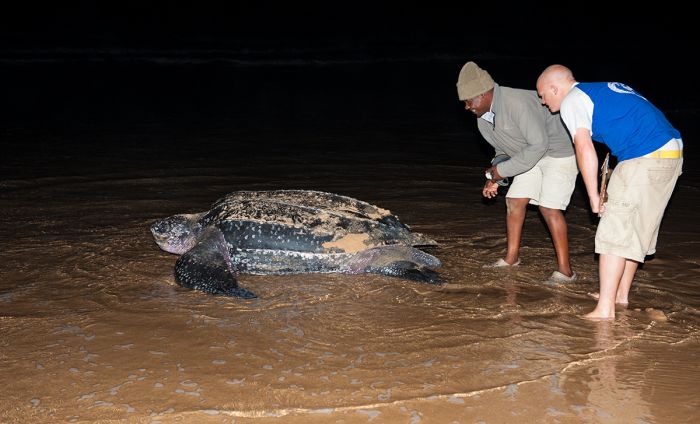
A leatherback turtle returns to the ocean after laying her eggs (Copyright © James Weis).
GAME RESERVES
Inland from the coast lie the wildlife reserves of Hluhluwe (pronounced roughly as "shloo-shloo-wee") and Phinda. These reserves are also active in conservation of wildlife, especially rhinos (both black and white species), and all of Africa's Big Five animals (lion, leopard, elephant, buffalo and rhino) can be seen here. Further inland are additional reserves including Thanda, Ithala and Pongola.
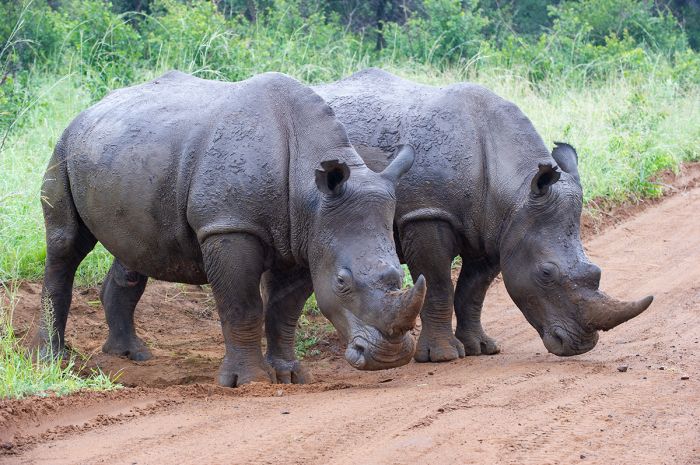
White rhinos are protected in the wildlife reserves (Copyright © James Weis).
ISIMANGALISO WETLAND PARK
The iSimangaliso Wetland Park is South Africa's third-largest protected area, covering 280 kms (175 miles) from the Umfolozi River in the south to the Mozambique border in the north and covers are area of 3 280 sq kms (1 266 sq miles). The park was renamed (it was formerly called the Greater St. Lucia Wetland Park) in 2007 and the new name means "a wondrous miracle" in the Zulu language.
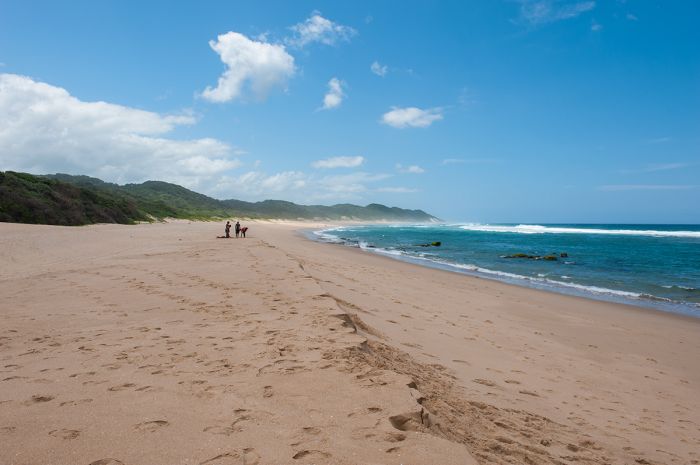
Pristine beach along the Elephant Coast (Copyright © James Weis).
Read More...
Hluhluwe-iMfolozi, iSimangaliso, Ithala, Northern KwaZulu-Natal, Phinda, Thanda, uMkhuze
Northern KwaZulu-Natal
The northern portion of South Africa's KwaZulu-Natal (KZN) Province is one of the wildest and most bio-diverse areas of the country. This region includes The Elephant Coast and iSimangaliso Wetland Park, and it stretches from the Umfolozi River in the south all the way to the Mozambique border in the north.
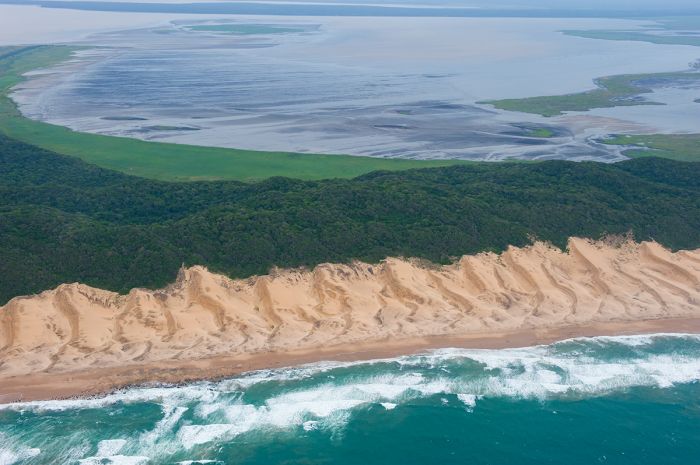
Sand dunes, coastal forest and iSimangaliso wetlands (Copyright © James Weis).
Once inaccessible to all but the most intrepid of off-road drivers, the coastline and wildlife reserves are now more easily accessed on tarred roads from the N2, although you'll still need a 4WD vehicle to reach some of the more remote spots along this 200-km (124-mile) stretch of nearly uninterrupted beachfront, dunes, coastal sand forest and warm Indian Ocean water.
Phinda Game Reserve
Established in 1991 and operated by the AndBeyond safari company, the Phinda (pronounced "pin-dah") Game Reserve is widely regarded as the best wildlife reserve in KZN.
The reserve was created in 1991 from overgrazed livestock, agricultural, and game farms, with a goal of rehabilitating the land to its natural state and eventually reintroducing the indigenous species that one lived there.
The property was completely fenced and the indigenous Zulu people living around the new reserve were employed, which invests these communities in the project. Over time the reintroduced wildlife thrived and safari tourism was introduced.
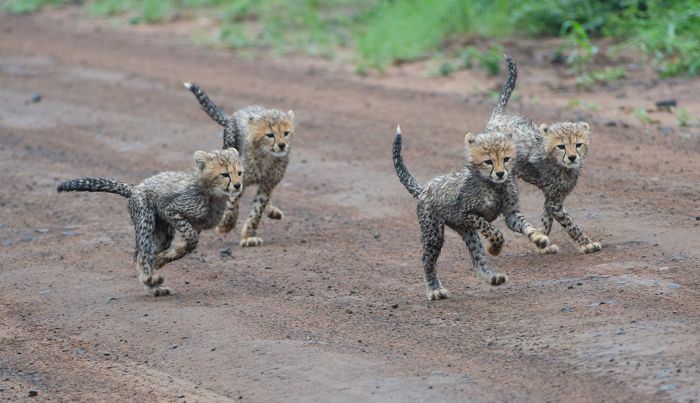
Baby cheetahs in the Phinda Game Reserve (Copyright © James Weis).
The Phinda Reserve covers 155 square miles (299 sq kms) and borders the uMkhuze section of the iSimangaliso Park to its north. The name 'Phinda' means "return" in the Zulu language, which refers to the return of this land from farming to its natural state and part-ownership to the local people.
The reserve has an incredible diversity of ecosystems, with seven distinct habitats ranging from savanna, woodland, wetland, dry sand forest, open bush, and mountain bush. There are are also dramatic rock outcroppings rivers, marshes, and rain pans. Phinda protects 3.9 square miles (10 sq kms) of South Africa's dwindling dry sand forest.
All of Africa's Big Five animals (lion, leopard, elephant, buffalo and both species of rhino) are found here, as well as abundant cheetah, spotted hyena, giraffe, impala, zebra, greater kudu, warthog, baboon, and more.
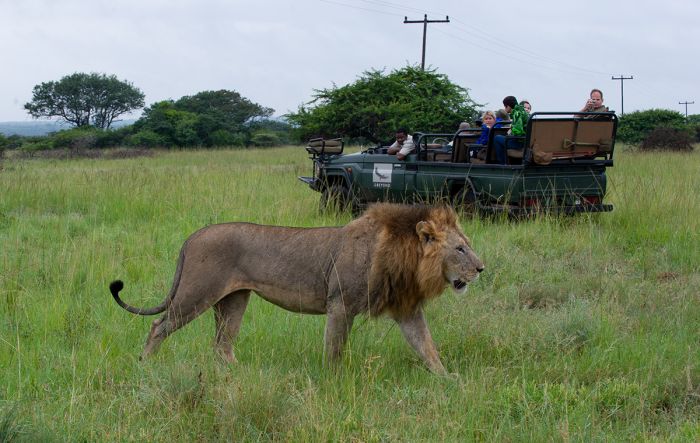
Male lion seen on game drive in Phinda Game Reserve (Copyright © James Weis).
Crocodiles and hippos are resident in the Mzinene River, which forms the reserve's southern border. Bird life is also abundant owing to the diverse habitats, with a species list over 400.
Phinda is involved with multiple ongoing research and conservation projects in the reserve, including efforts to study and conserve rhino, lion, cheetah, leopard, suni antelope, pangolin, and others. Guests are offered a chance to participate when the researchers are available.
The reserve offers several safari camps, all operated by the same company, which makes for an exclusive game viewing experience, and similar to that of the private reserves bordering Kruger National Park. The guiding is superb and game drives are conducted in open 4WD vehicles, with wildlife sightings well controlled to minimize vehicle numbers.
Visitors to Phinda will have a diversity of options for activities, including safari drives and bush walks in the reserve, as well as day trips to the unspoiled beaches and rich coral reefs of the Indian Ocean, located a short drive to the east. Sea turtle nesting on the beaches takes place between November and January.
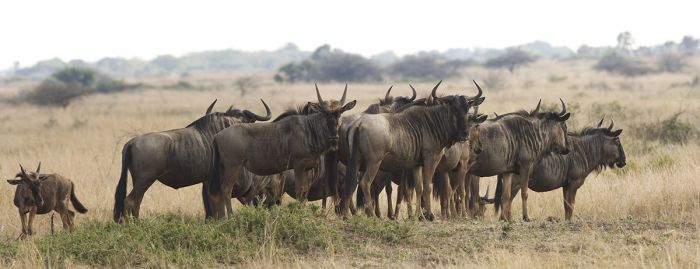
Blue wildebeests in the Phinda Game Reserve.
Hluhluwe-iMfolozi Game Reserve
The Hluhluwe-iMfolozi Reserve is a well-known conservation success story, most notably for its work protecting white rhinos. The reserve was originally two separate parks two separate parks, Hluhluwe (pronounced "shloo-shloo-wee") in the north and iMfolozi in the south, both created in 1895.
The R618 road that ran thru the once-fenced corridor separating the two reserves still remains, but the fences were removed in 1989 and the combined reserve has operated as a single entity ever since.
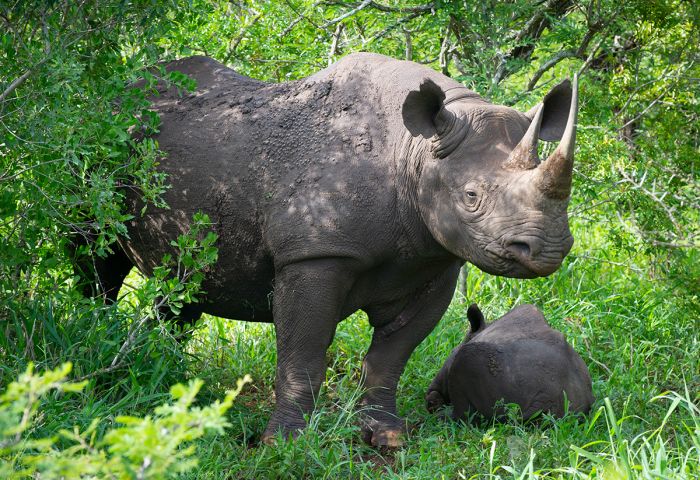
A black rhino and her calf in Phinda (Copyright © James Weis).
The reserve covers 350 square miles (906 sq kms) and offers some of the country's best game viewing, including all of the Big Five (lion, leopard, elephant, buffalo, and rhino), plus cheetah, spotted hyena, African wild dog, greater kudu, impala, zebra, giraffe, nyala, red duiker and more. Birding is also excellent.
Hluhluwe-iMfolozi is widely recognized for saving the white rhino from extinction in Africa and as early as 1960, its Rhino Capture Unit was responsible for relocating its abundance of these endangered animals to other parks and reserves in Africa.
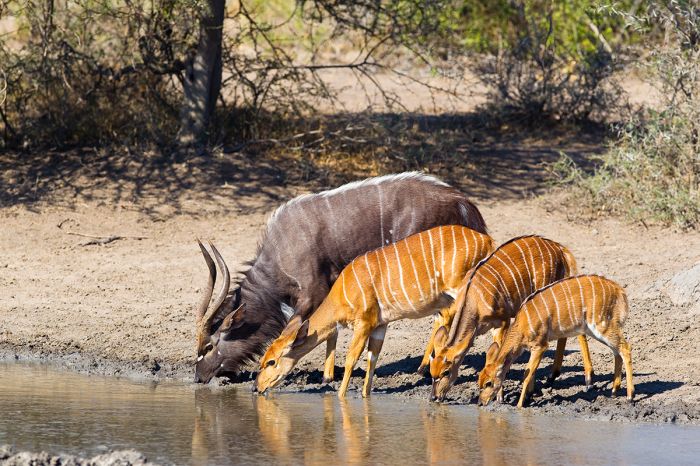
Nyalas drinking in the Hluhluwe-imFololzi Game Reserve.
Today it is the black rhino which faces ever severe pressure and reduced numbers, and the reserve's authorities hope to do the same for this species that they did for the white rhino. An estimated twenty percent of the country's remaining wild black rhinos live in the reserve.
There are plenty of options for accommodation, both inside the reserve or in the surrounding area.
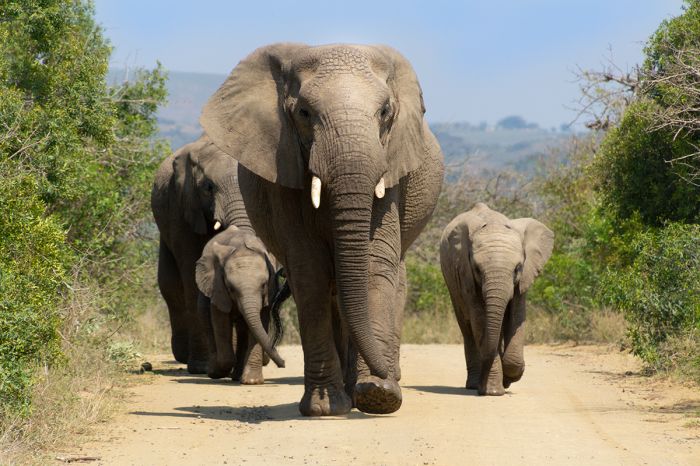
Elephants on the road in Hluhluwe-iMfolozi Game Reserve, KwaZulu-Natal, South Africa.
Thanda Private Game Reserve
Thanda is one of the newest reserves in KwaZulu-Natal, created in 2002 by a Swedish entrepreneur, who restored former farmland and hunting grounds to its original wild state.
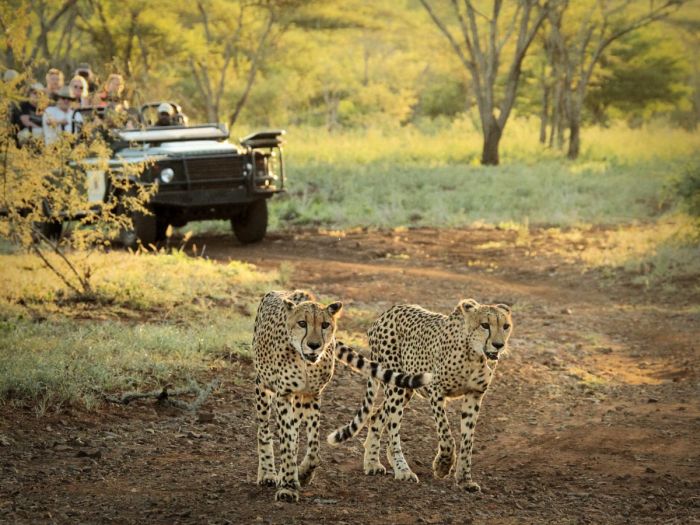
A pair of cheetahs seen in Thanda Game Reserve.
The reserve covers 60 square miles (150 sq kms) and has three safari properties which focus on a combination of wildlife, Zulu culture, conservation of the environment, and local community partnerships. Thanda means "love" in the Zulu language.
The wildlife at Thanda has been reintroduced with great success and guests have a good chance at seeing all of the Big Five animals, plus all of the region's general game species like, cheetah, hyena, Nyala, zebra, giraffe and more. One of the highlights at Thanda are the cultural interactions with the local Zulu people.
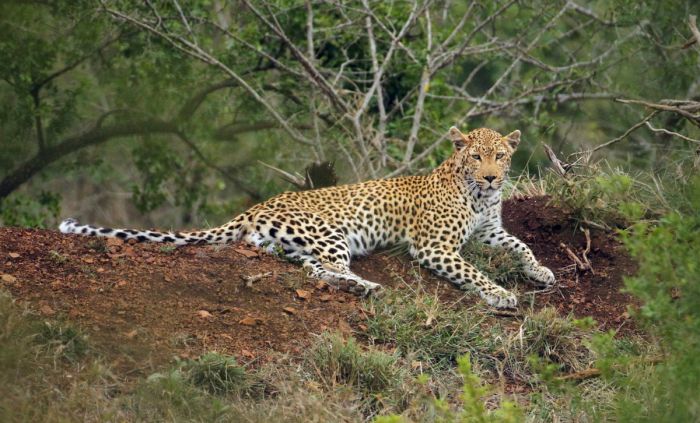
A leopard in Thanda Private Game Reserve.
uMkhuze
uMkhuze (also spelled Mkuzi, Mkhuzi, Mkuze, Mkhuze) was established in 1912 and is one of South Africa's oldest reserves. Covering 155 square miles (400 sq kms), uMkhuze has been incorporated into the greater iSimangaliso Wetland Park.
The reserve contains a huge diversity of habitats, from the Ubombo Mountain foothills on its western boundary, to savanna, wetland, riparian forest, and various varieties of woodland in its interior. The rare sand forest habitat that is well known in this region is also present in uMkhuze.
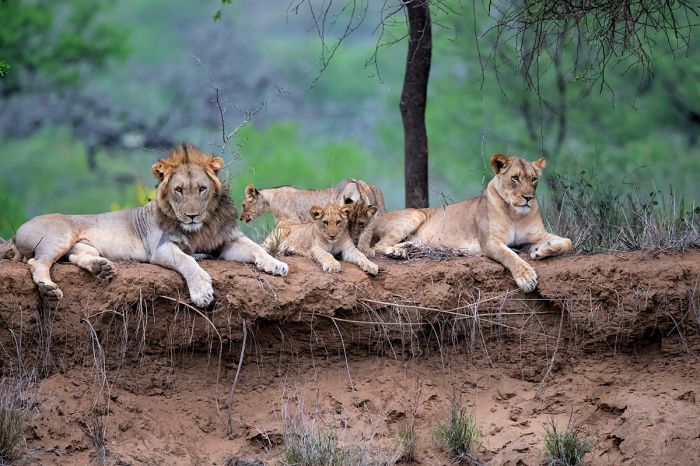
Lions on the bank of the Mkuze River.
Lions were reintroduced to the reserve in 2013 and all of Africa's Big Five animals are found in the reserve. The reserve hosts various conservation initiatives, including monitoring of cheetah, lion, African wild dog and elephant.
Other wildlife in the reserve includes spotted hyena, hippo, crocodile, giraffe, wildebeest, zebra, warthog, bush pig, baboon, vervet monkey, waterbuck, greater kudu, nyala, and impala. Lesser known small antelopes include sunny, steenbok and duiker.
uMkhuze is also famous for its huge number of bird species, owing to the rich diversity of habitats here. The reserve has recorded over 420 species and it attracts birdwatchers from around the world.
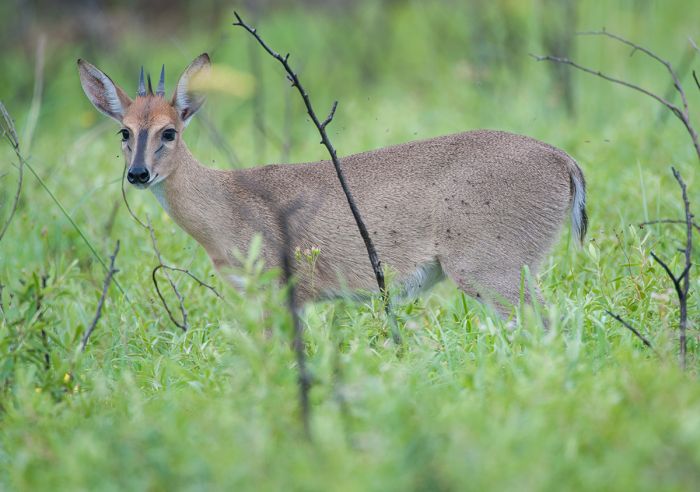
A common duiker (Copyright © James Weis).
Ithala Game Reserve
Situated close the the Swaziland border, Ithala was proclaimed in 1972 and covers just 114 square miles (296 sq kms), but makes up for its small size with its high diversity of habitats.
The reserve contains rugged terrain, with steep slopes descending down from the Ngotshe Mountains into a deep river valley. The landscapes include amazing rock formations, sandstone cliffs, gorges, waterfalls dropping into deep pools, grassland savannas, and massive plateaus.
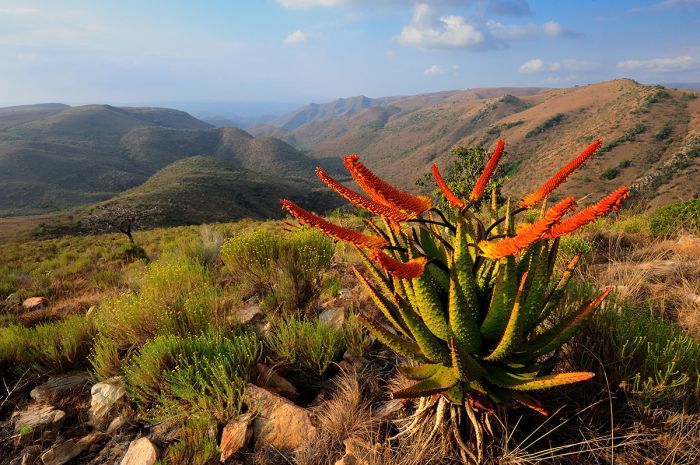
Aloes in bloom and view in Ithala Game Reserve.
There are no lions, but the other four of the Big Five (leopard, elephant, buffalo, and both species of rhino) are present in good numbers. Other wildlife includes cheetah, spotted hyena, brown hyena, giraffe, wildebeest, tsessebe, red hartebeest, mountain reedbuck, and many others. The reserve is also excellent for birders.
Accommodations include several exclusive bush camps and a main camp with chalets.
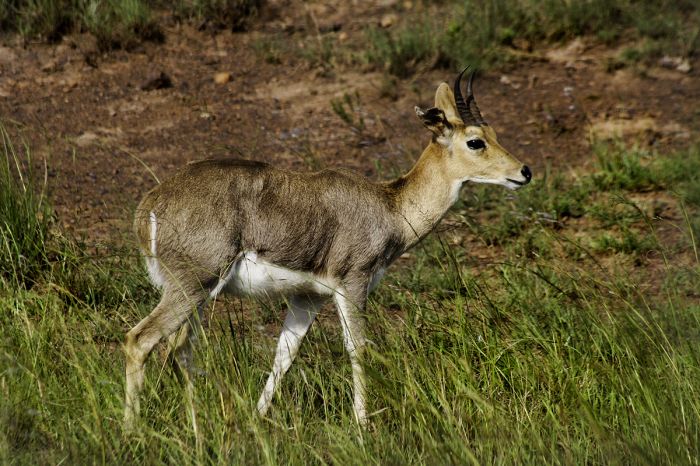
A mountain reedbuck in Ithala Game Reserve.
iSimangaliso Wetland Park
Previously known as the Greater St. Lucia Wetland Park (renamed in 2007), iSimangaliso Wetland Park is South Africa's third largest protected area, running from Maphelane in the south to the Mozambique border in the north. The reserve covers 1 266 square miles (3 280 sq kms), including 174 miles (280 kms) of coastline.
Due to its incredible diversity of habitats, including fragile offshore coral reefs, miles of pristine beaches, vegetated sand dunes (some of the world's highest), coastal sand forest, coastal dunes, grasslands, mountains, inland lake systems, estuaries, papyrus wetlands, iSimangaliso was declared as South Africa's first World Heritage Site in 1999.
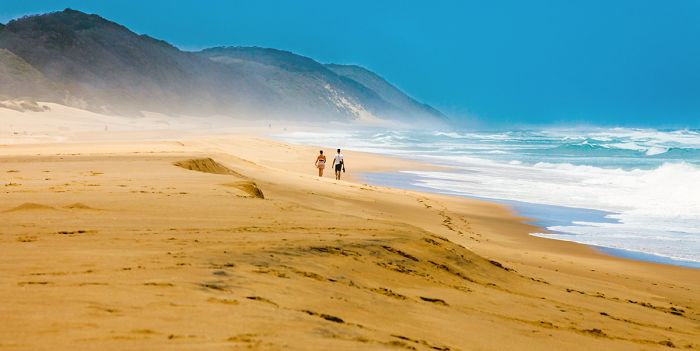
Towering vegetated sand dunes along the beach in iSimangaliso Wetland Park.
There are four Ramsar Wetlands of International Importance in iSimangaliso: Kosi Bay, Lake Sibaya, St. Lucia System, and Turtle Beaches/Coral Reefs of Tongaland.
The greater iSimangaliso Park is made up of several previously protected reserves that have been combined into a single national park:
- uMkhuze - borders the Phinda Game Reserve (formerly Mkuze Game Reserve).
- Maputaland Coastal Forest - the northern coastal portion that stretches to Kosi Bay and the Mozambique border (formerly the Maputaland Coastal Forest Reserve).
- Maphelane - the far southern coastal area stretching to the Umfolozi River (formerly Maphelane Nature Reserve).
- St. Lucia - the central coastal area that spans inland, protecting Lake St. Lucia and the associated wetlands (formerly the Greater St. Lucia Wetlands Park).
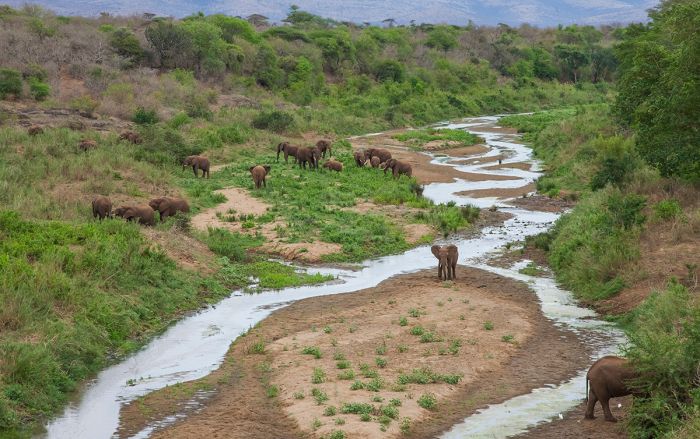
Elephants in a river bed near Sodwana Bay, iSimangaliso Wetland Park, KwaZulu-Natal, South Africa.
Wildlife in the reserve includes elephant, both black and white rhino, buffalo, hippo, and various antelopes including greater kudu, common reedbuck, waterbuck, bushbuck, red duiker, sun, and others. Predators sometimes seen include lion, leopard, and crocodile.
The offshore protected area is home to whales, dolphins, whale sharks, coral reefs and the resident tropical fishes that live among the coral. The remote beaches, especially in the northern parts of the reserve, are used by five species of marine turtle as nesting sites.
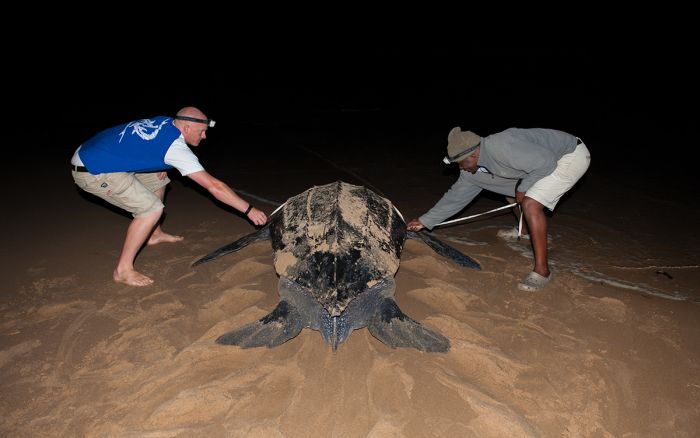
A leatherback turtle is returning to the water after laying eggs (Copyright © James Weis).
The turtle nesting sites are crucial to the survival of these species, especially for the critically endangered leatherback turtle, which is a genetically distinct population from leatherbacks found in the Caribbean. The turtles here have been under continuous research since the 1960s, and visitors staying at Rocktail Camp have an opportunity to ride along with researchers on late night nest monitoring or turtle release (seasonally available).
As expected in such a massive and diverse area, birding is spectacular throughout iSimangaliso, with a species list that tops 500.
The remote northern section of the reserve (previously known at the Maputaland Coastal Forest Reserve) is one of the best places in the country for SCUBA diving. Numerous offshore reefs hold some of the best tropical fish viewing anywhere in the world.
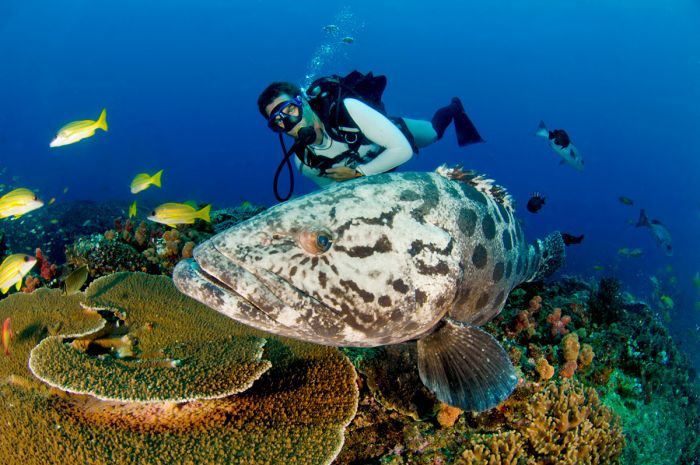
A potato grouper and diving along the northern section of iSimangaliso.
Read More...
Hluhluwe-iMfolozi, iSimangaliso, Ithala, Northern KwaZulu-Natal, Phinda, Thanda, uMkhuze
Great Good Fair Poor
- Jan
- Feb
- Mar
- Apr
- May
- Jun
- Jul
- Aug
- Sep
- Oct
- Nov
- Dec
INLAND GAME RESERVES
When to Visit
May thru September are the prime wildlife viewing months throughout much of Southern Africa and that rule holds here too. The winter temps are more comfortable and wildlife will tend to congregate at or near the permanent water sources as infrequent rains cause the landscape to dry up.
The vegetation is also more sparse during the winter and off-road driving is easier as the ground becomes hard and dry.
Summer is still very good game viewing, with thicker bush but spectacular colors and dramatic skies.
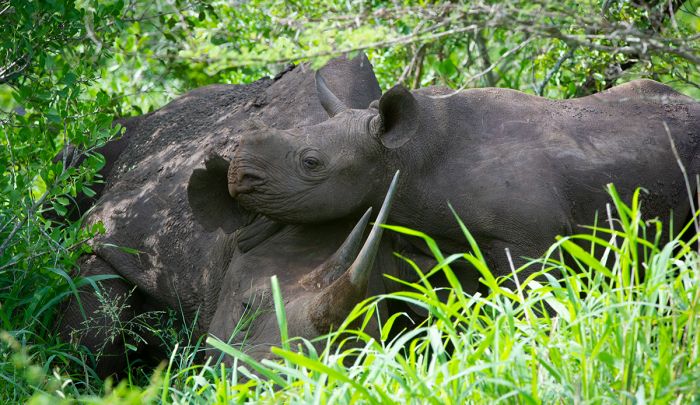
A baby black rhino photographed in January's greenery (Copyright © James Weis).
Summer / Rains
The wet season in eastern South Africa is during the summer, from October through April. This is summertime and it can best be described as hot and humid, with regular rainfall. January and February are usually the heaviest rain months, but October through December also receive substantial rainfall.
October and November can experience all-day rains and afternoon showers can be expected most days. Temperatures range from 63-66°F (17-19°C) at night and in the early morning to 80-83°F (26-28°C) in the afternoon.
December through February is a very rainy period, with afternoon showers almost every day, but usually not all-day rain. Daytime temperatures average 86-90°F (30-32°C), but it can be much warmer. Overnight temperatures are warm but pleasant, averaging 66-70°F (19-21°C).
The rains abate a bit during March and April and the daytime temperatures also begin to drop, bringing some relief after months of heat and high humidity. Temperatures during the afternoon average 82-86°F (28-30°C) and overnight temperatures drop to a comfortable 62-66°F (17-19°C).
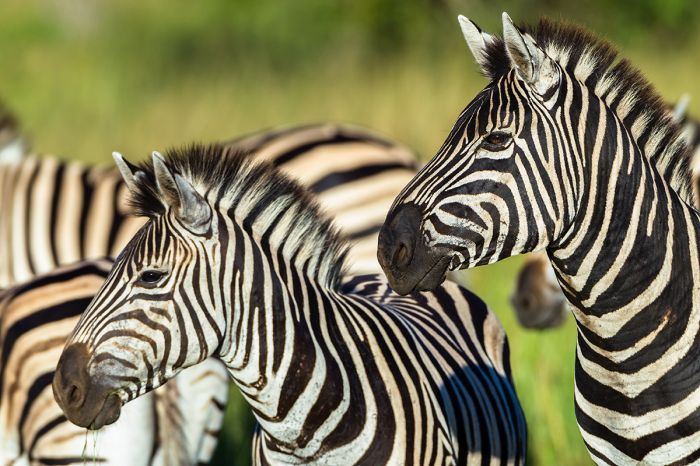
Plains zebras in the Phinda Reserve.
Winter
The winter months are from May through September and although rains can still occur at any time during the year, this is the driest period and the temperatures are also the most comfortable. Wildlife viewing is best during this period, as the bush dries and animals are congregating around water sources.
May sees a decrease in the summer rains and high humidity, but the bush is still lush and thick after the long summer. Daytime temperatures average 78-80°F (26-27°C) and drop to a pleasant 56-58°F (13-14°C) overnight.
June through August are an excellent time for wildlife viewing in KwaZulu-Natal. Rain is very infrequent and temperatures continue to drop, with mornings being quite chilly, which requires dressing in layers for the the early morning. Daytime temperatures average 76-78°F (24-25°C) but overnight can be cold, averaging 51-53°F (10-11°C). Bring warm clothes if you plan to visit during this period!
September offers prime wildlife viewing and very pleasant temperatures. Rainfall is infrequent but starting to increase a bit heading towards the coming wet season and it is slowly getting warmer as springtime has arrived. Daytime temperatures average 80-83°F (27-28°C) and the chilly nighttime temps of winter are now not so cold, averaging 58-60°F (14-15°C). Early morning activities will still require dressing in layers.
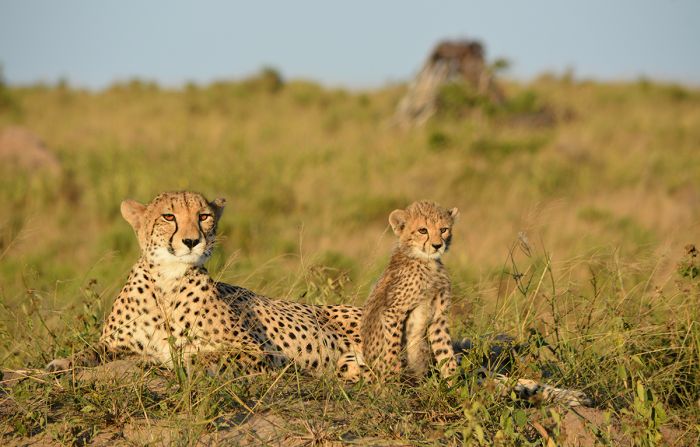
A cheetah and her cub in the Phinda Reserve.
The Coast
Summer / Rains
In general, coastal Kwazulu-Natal experiences a warm to hot sub-tropical climate all year, but it can be especially hot and humid from November thru February. Most of the rain falls between November and March and heavy thunderstorms occur regularly. Daytime temperatures during the summer months average 82-86°F (28-30°C) with high humidity.
Winter / Dry
The winters (May thru October) are dry and cooler along the coast, with war, daytime temperatures, but cooling down at night. Daytime temperatures average 72-76°F (22-24°C).
Turtles
Turtle nesting season along the coast of KwaZulu-Natal occurs from November to January, when loggerhead and leatherback turtles come ashore to lay their eggs in the sands of the remote northern beaches. The incubation period for the turtle eggs is around 60 days.
Diving
SCUBA diving is good all year in the offshore waters of KwaZulu-Natal with the exception of September, when the seas can become too choppy. Sea temperatures typically do not fall below 68°F (20°C), but reaches 83°F (28°C) during the summer months.
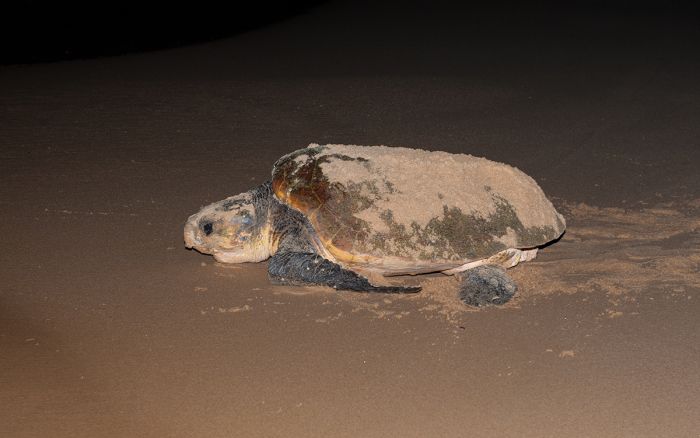
A loggerhead turtle returns to the sea after laying her eggs (Copyright © James Weis).
Showing 1–5 of 5 results
Situated in a rare sand forest within a large, privately-managed wildlife and conservation reserve. Diverse wildlife, including all of the Big Five, cheetah, plus adventures in the nearby Indian Ocean.…
Excellent safari experience in a large, privately-managed wildlife and conservation reserve with diverse wildlife, including all of the Big Five, cheetah, and all the regional plains game species. Great for families with children.…
Small and intimate lodge offering an excellent safari experience in a large, privately-managed wildlife and conservation reserve. Diverse wildlife, including all of the Big Five, cheetah, and all the regional plains game species. No children under 12 years.…
Offers an excellent safari experience in a large, privately-managed wildlife and conservation reserve with diverse wildlife, including all of the Big Five, cheetah, and all the regional plains game species.…




